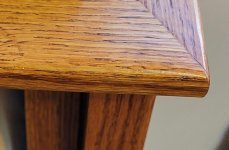motorhead9999
Member
- Joined
- Nov 10, 2022
- Messages
- 5
I’m currently making a desktop, a bit new to furniture style projects and this is going to be my first experience using dominoes. The desktop is going to be made out of cabinet grade maple plywood, and is 1.5” thick around the edges. I’m going to put 3/4” solid maple wood around the plywood edges attached via dominoes. My questions are
1) is there a recommended or rule of thumb for how many dominoes you need along the length of a joint? For reference, my longest desk side is 63 inches
2) for each spot along the length, is it fine to use a single domino centered on the 1.5” thickness, or should I use two smaller dominoes at each location, at the top and bottom of the mating face?
And in general:
3) Is it better to have the front length of maple be one continuous piece across the whole of the front of the desk (and thus covering the side maple pieces, or should the point where the two maple pieces be mitered at 45 degrees at the corner?
1) is there a recommended or rule of thumb for how many dominoes you need along the length of a joint? For reference, my longest desk side is 63 inches
2) for each spot along the length, is it fine to use a single domino centered on the 1.5” thickness, or should I use two smaller dominoes at each location, at the top and bottom of the mating face?
And in general:
3) Is it better to have the front length of maple be one continuous piece across the whole of the front of the desk (and thus covering the side maple pieces, or should the point where the two maple pieces be mitered at 45 degrees at the corner?

